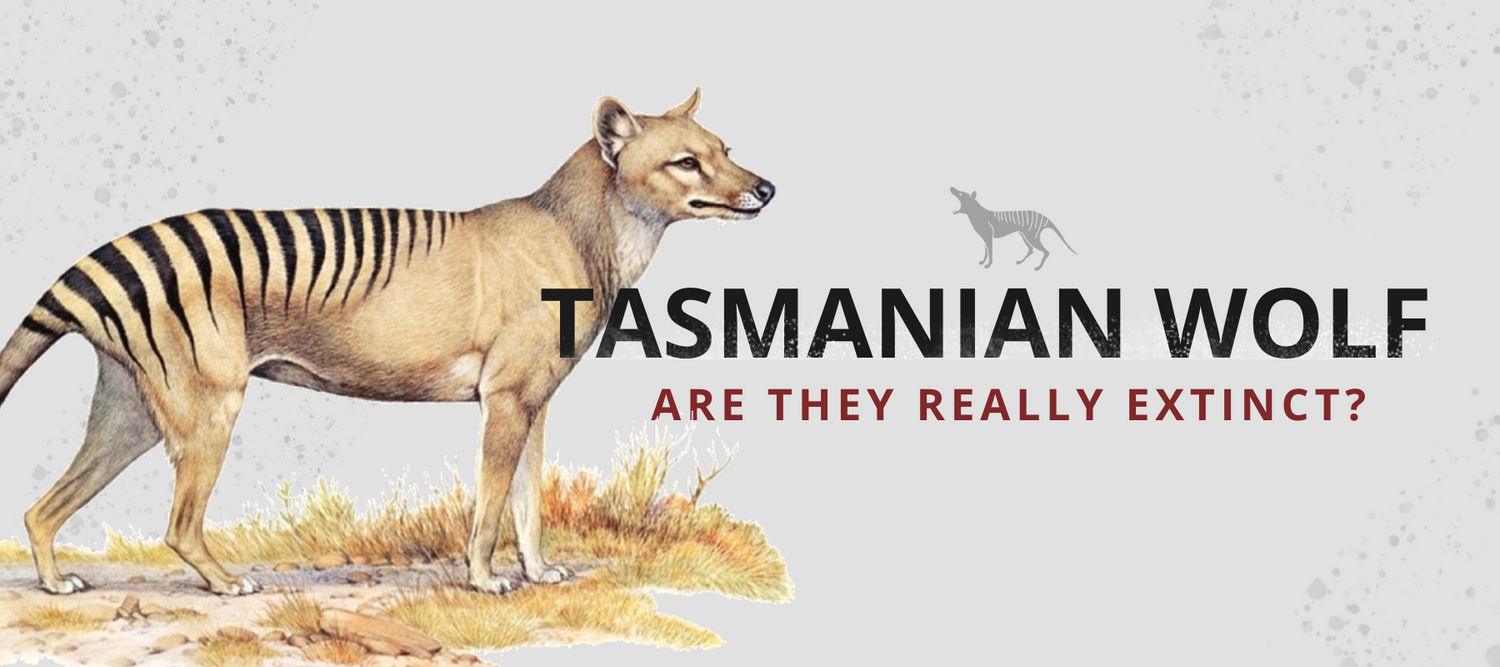Also known as the marsupial wolf, Tasmanian wolf or Tasmanian tiger, this animal is a carnivorous marsupial mammal the size of a wolf, with a tiger-like coat. Long considered an extinct species, recent observations and research suggest otherwise. If you want to know everything about this incredible species, you've come to the right place! In this article we will review the characteristics of the Tasmanian wolf and discover together if the species is really extinct.

WHAT IS A TASMANIAN WOLF?
The Tasmanian wolf, or thylacine (Thylacinus cynocephalus), also known as Tasmanian tiger was a carnivorous marsupial that lived in Australia, from where it disappeared 3,000 years ago. The population was limited to the island of Tasmania and survived there until the beginning of the 20th century. It was the arrival of European shepherds that hastened the end of the species, especially since the government offered a reward for each animal killed. The last known thylacine died in captivity in 1936.
Thylacine has a marsupial pouch in which the young develop. Its back has characteristic stripes, hence its name. Anatomically, it looks very much like a canid but is not at all related to it since marsupials diverged from the rest of mammals a long time ago, long before the appearance of the canids and the Tasmanian wolf.
To learn more about the evolutionary history of these animals, an international team of researchers wanted to sequence their genome.
To do so, they used a well-preserved specimen of a 106-year-old male from an Australian museum collection. The DNA was extracted and sequenced, allowing the thylacine to be placed back into a phylogenetic tree. Andrew Pask, one of the authors of this work, explained in a release from the University of Melbourne that "the Tasmanian wolf belongs to a sister line of the Dasyuridae, the family that includes the Tasmanian devil and the marsupial mouse.”

IS THE TASMANIAN WOLF EXTINCT?
Officially, the Tasmanian wolf became extinct in 1936, when the last representative of the species died at Hobart Zoo on the southern Australian island of Tasmania. On the Australian continent, it is believed to have been extinct for centuries.
However, people regularly claim to have seen animals that are neither dingoes nor foxes and which resemble the extinct animal. Stories that have long been judged with a great deal of scepticism.
Recently, two people are reported to have seen animals that may be Tasmanian wolves in northern Queensland.
The animals are believed to have been observed in two different locations on the Cape York Peninsula, their exact location is kept secret. The evidence provides plausible and detailed descriptions: the description of the eyes, size, shape and behavior did not correspond to any of the larger northern Queensland species (dingo, wild dog or wild boar).
WHY DID THE TASMANIAN WOLF BECOME EXTINCT?
The species had been subjected to the action of human, and more precisely of European settlers, who had hunted it massively in Tasmania. The genome also showed that the Tasmanian wolf was in poor genetic health, with low genetic diversity, even before humans arrived in Australia. The Tasmanian devil, its close cousin, suffered from the same problem of low genetic diversity before it was isolated in Tasmania.

WHAT WAS THE TASMANIAN WOLF DIET?
Tasmanian wolves were carnivorous. They mainly hunted kangaroos, sheep and wallabies, although there is little research on their eating habits. These animals could open their mouths to nearly 90 degrees, according to the Encyclopedia Britannica.
However, a study published in the August 2011 Journal of Zoology found that the Tasmanian tiger did not kill large, large prey because of its small jaw. The authors thought the animal would have hunted small marsupials such as wallabies and possums.
HOW DID THE TASMANIAN WOLF HUNT?
Currently, four thylacine brains have been preserved to support research into the hunting behavior of these animals. For this study, two of them have been analyzed using MRI. In order to best interpret the results, the scientists carried out the same analyzes on brains of Tasmanian devils (Sarcophilus harrisii), a species that happens to be phylogenetically close to Thylacinus cynocephalus.
They found that in addition to a larger brain size, Tasmanian wolves had a larger cortex in the brain areas devoted to planning and decision-making.
Areas that are highly solicited by hunting behavior. In short, these results indicate that thylacines had predatory behavior, unlike Tasmanian devils, which are opportunistic animals with a tendency to scavenge. The developed areas of his brain suggest that his hunting techniques were close to those of the gray wolf.🐺
TASMANIAN WOLF CLONING
Using fragments of flesh and skin from the missing marsupial thylacin, researchers isolated a gene and made it functional by integrating it into a mouse genome. This result is a first and offers hope for a new way to study recently extinct species, as well as a better understanding of the mechanisms of evolution.
The goal of Andrew J. Pask, Richard R. Behringer (University of Texas) and Marilyn B. Renfree (University of Melbourne) was not to create a chimera or to try to bring back to life an extinct animal in the manner of the Jurassic Park scenario.🦖 The three researchers wanted to study Thylacinus cynocephalus, or thylacine, or Tasmanian tiger, or marsupial wolf, more closely.
These genes were successfully inserted into mouse embryos where they were correctly integrated into the genome. Thanks to specific staining, the researchers demonstrated that the Tasmanian wolf enhancer was indeed expressed to stimulate the activity of chondrocytes, the cells that make cartilage (which will become bone).
Other researchers at the Australian Museum thought they might be able, through genetic manipulation, to bring the Tasmanian wolf back to life. The DNA from a small wolf preserved in ethanol had been successfully reproduced, making it theoretically possible to resurrect the species within a decade. A fragment of this DNA had yet to be introduced into the sex cells of another marsupial who would have served as a surrogate mother.🧬
However, in February 2005, the Australian Museum gave up cloning the Tasmanian tiger. The new director believes that the genetic material available to the museum is too damaged to allow the animal to be cloned.
Some believe the project is unworkable. This is not the opinion of Professor Archer, the initiator of the project, who hopes that his idea can one day be carried out elsewhere than at the Museum.

TO SUM UP
Our knowledge of the Tasmanian wolf is, as yet, rather sparse. However, we are hopeful that we will discover more about this incredible species thanks to new technologies and studies conducted by scientists. Numerous sightings of the animal, recorded by local residents, also suggest that this species will reappear one day!
If you are a true wolf lover, check out our wolf clocks collection. And if you would like to find out more about the wolf's incredible species, check out our article on gray wolf species.



